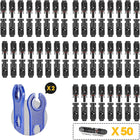7 Easy Steps to Safely Transport a Mini Fridge in a Car

Are you planning on moving a mini fridge? Whether you’re setting up a new office space or simply bringing home your latest purchase, it's essential to know how to transport a mini fridge safely in your car. Moving a mini fridge might seem straightforward, but doing it incorrectly can lead to damage to both the fridge and your vehicle.
In this blog, we’ll walk you through everything you need to know to ensure your mini fridge arrives at its new spot in perfect working condition. Let’s explore the detailed steps to transport a mini fridge in a car now!
7 Easy Steps to Transport a Mini Fridge in a Car

Now check out the following 7 steps, and you'll ensure that you can successfully move the mini fridge by yourself.
1. Prepare Your Mini Fridge for Transport
-
Empty the contents: Start by removing all items from inside the fridge. This not only reduces weight but also prevents items from shifting during transport, which could cause internal damage.
-
Defrost and clean: If your mini fridge has a freezer compartment, make sure to defrost it at least 24 hours before moving. After defrosting, clean the interior with a mild cleaner to prevent odors and mold growth.
-
Secure loose components: Remove or secure shelves, drawers, and any other loose components inside the fridge. Wrap them separately to avoid damage.
-
Tape the door shut: Use strong tape, like duct tape, to keep the door closed during transportation. This will prevent it from swinging open and getting damaged or causing injury.
2. Choose the Right Vehicle
Transporting a mini fridge requires a vehicle large enough to accommodate its size while allowing for safe maneuvering. Ideal vehicles include SUVs, minivans, or hatchbacks with ample trunk space. Make sure the back seats of your car fold down if you need extra space.
3. Gather Necessary Supplies
To move your mini fridge safely, you'll need:
-
Moving blankets or thick pads: These provide cushioning and protect both the fridge and your vehicle from scratches.
-
Straps or ropes: To secure the fridge during transport.
-
A dolly or hand truck: If available, a dolly can make the moving process much easier, especially if you have to navigate stairs.
4. Loading the Mini Fridge into Your Car
-
Use proper lifting techniques. When lifting the fridge, bend your knees and keep your back straight. Lift with your legs, not your back, to avoid injury.
-
Positioning in the vehicle. Ideally, place the mini fridge upright. This is how it functions and should travel that way if possible. Tilting it on its side can cause the coolant to flow incorrectly, potentially damaging the unit. However, if space constraints require laying the fridge down, always lay it on the opposite side of the compressor. Then, use moving blankets or pads to cushion the base and sides of the fridge inside your vehicle.
-
Secure the Fridge. Once in place, use straps or ropes to firmly secure the fridge to the car, preventing any movement. Be careful not to tighten straps over sensitive areas like the compressor.
5. Transporting Your Mini Fridge
Take smooth, slow turns and avoid bumpy roads if possible. Sudden stops or extreme jolts can damage the fridge. Avoid leaving the mini fridge in a hot car for too long, as high temperatures can damage its components.
6. Unloading and Setting Up
Once you arrive at your destination, carefully unload your mini fridge. If it was transported lying down, do not plug it in immediately. Set it upright in its final spot and wait at least 24 hours before plugging it in. This allows the oil in the compressor to settle, preventing potential damage.
7. Check Functionality
After the waiting period, plug in the fridge and monitor its functionality. Check for proper cooling and listen for any unusual noises. If something seems off, consult the manual or call a professional for advice.
Maintenance Tips Post-Transport
Keep your mini fridge running smoothly after transport by keeping it clean and defrosted regularly. Ensure there’s adequate ventilation around the fridge to prevent overheating and energy inefficiency.
How to Transport BougeRV’s Mini Fridge in a Car

-
Make use of the sturdy handles for easier lifting and maneuvering. BougeRV's 12V small fridges are well-weigh, allowing you to easily move the fridge with the handles and then place it in your car.
-
Secure the fridge with straps or ropes to prevent it from shifting during transit.
-
Place the fridge on a flat surface in the car, ideally in the trunk, front passenger seat, or backseat, to keep it stable.
-
Avoid placing heavy objects on top of the fridge.
-
Drive carefully to minimize jostling and potential damage to the fridge.
Conclusion
Transporting a mini fridge in your car doesn’t have to be a daunting task. By following these detailed steps, you can ensure that your mini fridge is moved safely and efficiently. Remember, the key to successful transport is preparation and patience. With the right method, your mini fridge will be chilling efficiently in its new spot without any problems.
Learn More: Can You Run a Fridge off a Car Battery?















































































































































































































